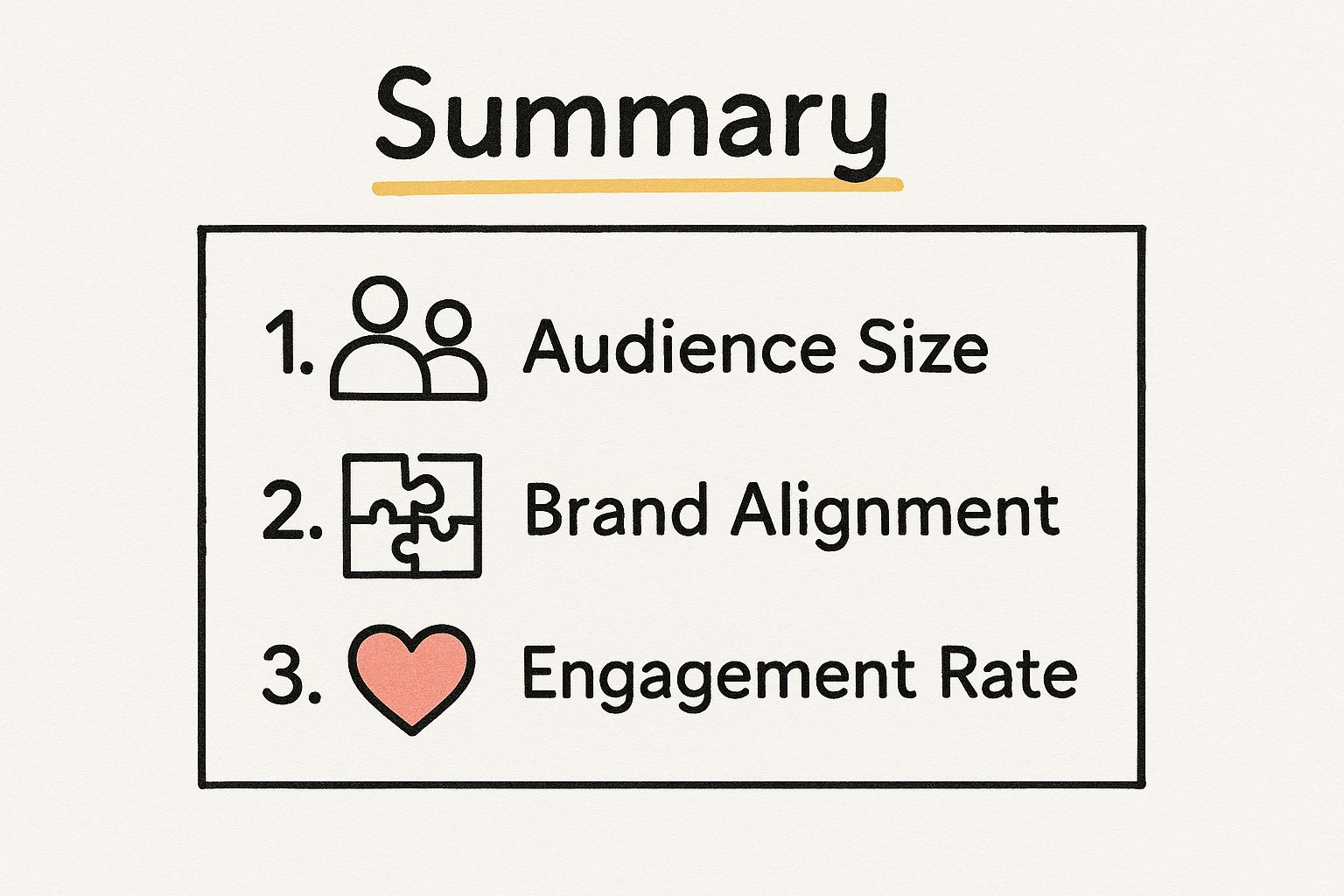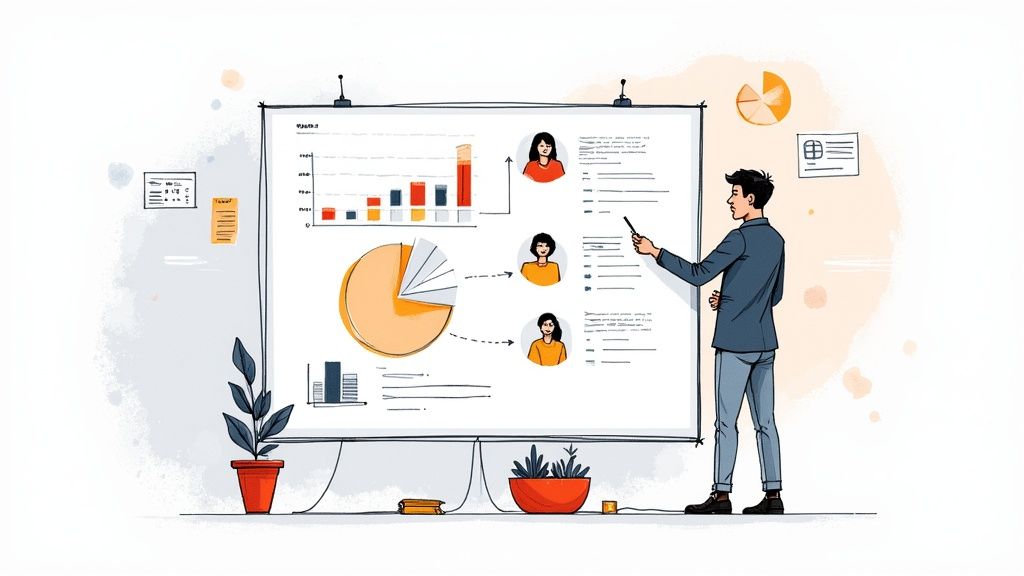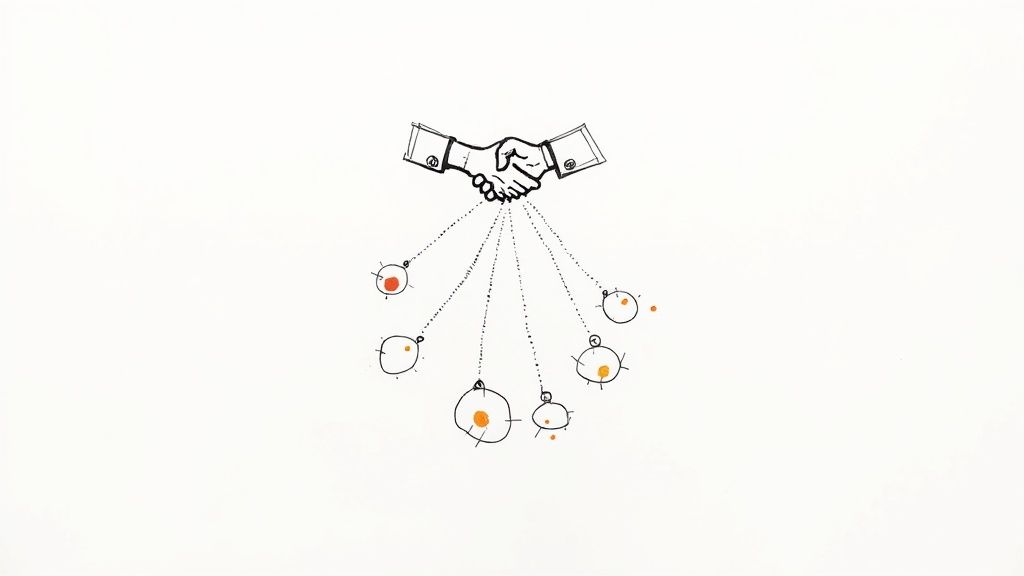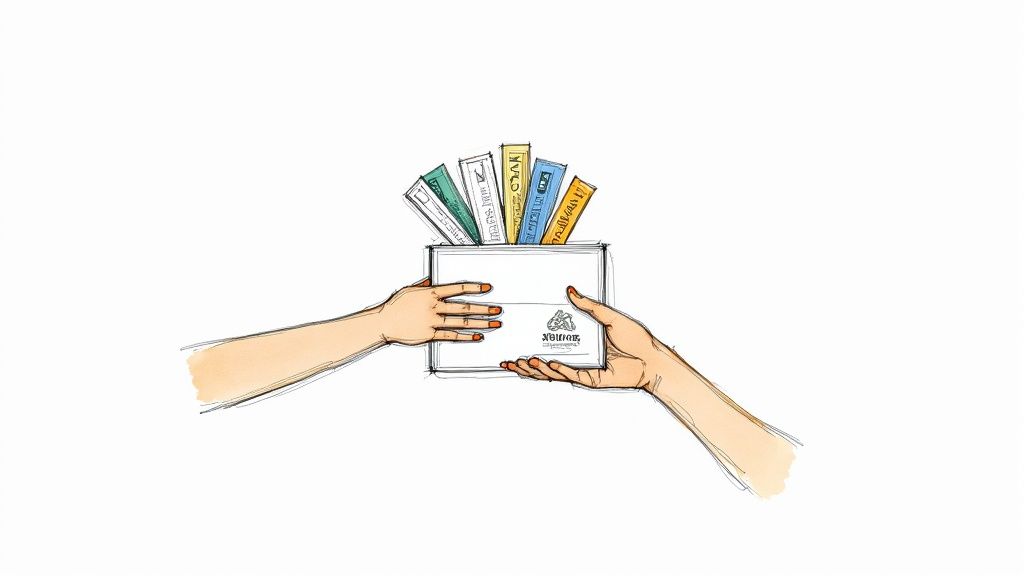August 9, 2025

When you're trying to get a sponsor for your blog, event, or channel, everything boils down to proving your value. This means you need a solid foundation in place long before you ever send that first outreach email. It's about knowing your audience, defining what you can offer, and setting crystal-clear goals.
Before you even dream of writing a pitch, you have to do the strategic homework. This prep work is often the deciding factor between landing a great sponsorship and getting ghosted. You need to shift your mindset from "asking for money" to "offering a valuable business partnership."
A sponsor isn't a charity. They're an investor, and investors expect a return. Your job is to build a compelling case that shows them exactly how they'll get one by partnering with you. This takes some real introspection and a good hard look at your data, almost as if you were a marketing manager analyzing your own brand. What are your core assets? What makes your audience so special?
Sponsors aren't paying for access to a generic crowd; they're investing in a specific, highly engaged community. Simply knowing basic demographics isn't enough anymore. A brand sponsoring a tech podcast isn't just targeting "men aged 25-40." They're looking for people with specific job titles, a certain level of purchasing power, and a genuine interest in trying new software.
To nail this, you need to create a detailed audience persona. Dive into your analytics and uncover:
A well-defined audience is your single most valuable asset. The more precisely you can describe who you reach, the easier it is for a sponsor to see a perfect match with their own marketing goals.
So, what makes partnering with you an opportunity a brand can't afford to miss? Your unique value proposition (UVP) is a clear, confident statement that outlines the benefits you offer, how you solve a sponsor's problem (like breaking into a new market), and what makes you different from everyone else asking for their budget.
Your UVP is more than just big numbers. It’s about the unique trust you've built with your audience and the creative ways you can weave a partner’s brand into your content. This is absolutely critical in crowded spaces. For example, the global sports sponsorship market is projected to hit an incredible USD 132.86 billion by 2033—a clear sign of both the massive opportunity and the fierce competition. To stand out, you have to offer more than just a logo on a t-shirt. You can read the full research on the sports sponsorship market to grasp just how fast this industry is expanding.

As the image shows, it's the combination of Audience, Alignment, and Engagement that tells the full story of the value you bring to the table.
Before you start building your prospect list, it's a good idea to make sure you have all your ducks in a row. This simple checklist covers the essential elements that sponsors will expect you to have clearly defined.
Having these pieces prepared not only makes your pitch stronger but also shows potential partners that you are serious, professional, and ready for a real business collaboration.
Finally, you absolutely must know what you're asking for and why. Vagueness is a deal-killer. Are you seeking a cash investment to cover specific event costs? Or are you looking for an in-kind sponsorship, like product for giveaways or free software licenses for your team?
Get specific. Don't just say you need "funding." Instead, state that you need "$5,000 to cover the venue rental and speaker fees for our annual conference." This level of clarity shows you're professional and helps a sponsor see exactly how their money will be put to work. Clear goals also make it much easier to measure success and report back to your partner, which is the first step toward building a fantastic long-term relationship.

Stop wasting your time pitching to every brand with a pulse. If you're serious about getting sponsored, you have to think strategically. The real wins come from finding companies where the partnership just makes sense—where their mission and your audience genuinely connect.
Instead of just casting a wide net and hoping for the best, you need to become a bit of a detective. The goal is to build a highly targeted list of prospects who are already primed to say yes. Why? Because you've already done the homework to prove your audience is exactly who they want to reach. This kind of precision will absolutely skyrocket your success rate.
The most powerful partnerships feel natural because they are natural. Before you go searching for big names, just look around you. What products, software, or services do you already rely on in your business or daily life? It's a simple but effective starting point.
If you’re their ideal customer, there’s a good chance your audience is, too.
Starting with brands you genuinely love gives you a few major advantages:
Go ahead and make a list of these companies. This is your "warm" prospect list—a group of brands you already have a connection with, even if they don't know it yet.
Your direct competitors are a goldmine of sponsorship leads. Take a close look at who is sponsoring their podcasts, newsletters, or events. These brands have already put their money where their mouth is, showing they understand the value of your specific niche and have a budget for it.
Now, this doesn't mean you should try to steal their sponsors. Instead, think of it as market research. For example, if your biggest rival is sponsored by Mailchimp, that's a huge clue. It tells you that other email marketing platforms like ConvertKit or ActiveCampaign are likely looking to sponsor creators in your space to compete for that same audience.
A brand sponsoring your competitor is your proof of concept. It validates that there’s a budget and an interest in reaching your audience. Your job is to show them why you're a better or different partner for that investment.
Before you add any company to your final list, you need to do your due diligence. A great sponsorship is about more than just matching demographics; it's about shared values. A recent study found that 82% of consumers want a brand's values to align with their own, and that trust extends to who that brand partners with.
Here’s a quick checklist for vetting a potential sponsor for brand alignment:
Let's say your blog is all about sustainable travel. Pitching a fast-fashion brand would create a massive disconnect and could seriously damage your credibility. But a company selling eco-friendly travel gear? That’s a perfect match. This deep dive is non-negotiable.
If you're ready to take these ideas further, our complete guide on how to get sponsorship breaks down even more advanced strategies for building these critical brand partnerships.
Let's get one thing straight: sending out a generic, one-size-fits-all proposal is a fast track to the trash folder. If you want to consistently land sponsors, you have to stop thinking like you're asking for money and start acting like you're offering a can't-miss business opportunity.
The most successful creators I know have all had this realization. They understand that brands aren't just buying a logo placement; they’re buying access to an audience, tangible results, and creative ways to engage with potential customers. Your job is to package your assets—digital exposure, event signage, content collaborations—into structured, compelling tiers that make it easy for a sponsor to say "yes."
First, a crucial mindset shift is in order. A sponsor’s logo on a webpage is table stakes. It’s a vanity metric that, on its own, offers almost no provable return. You have to go deeper and think about the tangible business outcomes a brand is actually after. What problems can you genuinely solve for them?
Every single item in your sponsorship package needs to connect back to a specific, valuable outcome for the sponsor. This immediately changes the conversation from "How much does it cost?" to "What amazing results can we achieve together?"
The secret to a great sponsorship package isn't what a brand gives you; it's what you give them. Focus on delivering measurable value, and the investment will naturally follow.
Organizing your offerings into tiers is a battle-tested strategy for a reason. Whether you call them Bronze, Silver, and Gold or get creative with names like "Partner," "Innovator," and "Visionary," this approach works. It taps into a psychological principle called price anchoring, where the higher-priced tiers make your mid-range options feel incredibly reasonable and packed with value.
Each level should build on the one before it, offering progressively more value and exclusivity. For a much deeper dive into building these levels effectively, check out our guide on creating high-value event sponsorship packages. A well-designed tiered system simplifies the decision-making process for a busy marketing manager.
Here’s a simplified look at how this could play out:
This table makes it crystal clear how the value stacks up with each tier, justifying the price jump and empowering sponsors to choose what fits their strategy.
Vague promises are deal-killers. To make your offer truly irresistible, you need to bolt specific, quantifiable metrics onto every single deliverable. This is how you show a clear Return on Investment (ROI) and give your contact the hard data they need to get the budget approved.
Don't just say "social media promotion."
Instead, say:
Don't just offer "a spot in our newsletter."
Be much more specific:
This data-driven approach builds instant credibility. It shows you're a professional who understands marketing and is focused on delivering results, not just a creator with their hand out. When you quantify your value, you completely change the dynamic and position yourself as a strategic partner they can’t afford to ignore.

Let's be honest. You can have the most brilliant proposal and perfectly crafted sponsorship packages, but they mean nothing if they land in the wrong inbox or just get ignored. This is where all your hard work meets the real world. Your outreach and pitch are the moments you turn a compelling offer into a real conversation—and, with any luck, a partnership.
Effective outreach is a game of precision, not just spraying and praying. Firing off a hundred generic emails won't get you nearly as far as five highly personalized, strategic messages. The real goal isn't just getting your email opened; it's to spark a genuine dialogue with the right person.
Your first big hurdle is tracking down the actual decision-maker. Sending your pitch to a generic info@company.com address is like shouting into the void. You've got to find the individual whose job it is to build brand partnerships and make these kinds of decisions.
Start your hunt with specific job titles. Hop on LinkedIn and look for people in roles like:
Once you've got a name, you can use tools like Hunter or RocketReach to dig up their professional email address. Taking this extra step shows you've done your homework and that you respect their time.
Your first email is your first impression. It needs to be short, personal, and focused on value. Forget the stuffy, corporate jargon. Let your personality shine through while still showing you mean business.
A great first email doesn't try to sell everything at once. Its only job is to get a positive reply and crack the door open for a real discussion. The secret is to make your message about them first, then connect it back to the opportunity you're presenting.
Real-World Scenario: Pitching a Tech Conference
Imagine you run a popular podcast for software developers and you've spotted a new project management tool that would be a perfect sponsor.
Your subject line could be something punchy and relevant, like: "Your new feature & our developer audience"
Then, open your email with a genuine compliment: "Hi [Contact Name], I've been following the launch of your new AI-powered scheduling feature—it’s a brilliant solution for agile teams. As a long-time user of your platform, I was incredibly impressed."
This one-two punch immediately shows you're a real user, not just some random person with their hand out. From there, you can briefly introduce your podcast and its engaged audience, creating a natural bridge to a potential partnership.
The most effective pitches feel less like a sales request and more like a strategic idea from a fellow professional. Frame your outreach as a collaboration, not a transaction.
When someone shows interest, they'll probably ask for more details. This is your cue to send over your pitch deck. Think of it as a visual story that uses data and a compelling narrative to build a powerful case for sponsorship. For an even deeper dive on this, our guide on how to get a sponsor has some fantastic insights.
Your deck needs to be clean, visually appealing, and easy to skim. Make sure it includes:
People are busy. A lack of response doesn't automatically mean "no." More often than not, a polite and professional follow-up is what it takes to get things moving.
Wait 3-4 business days, then reply directly to your original email with a simple, friendly nudge. The best follow-ups add a little extra value. You could say something like, "Just wanted to follow up on my idea. I was thinking a sponsored workshop could be a great way for you to demo the new feature to our community." This shows you're still thinking about their success.
This kind of thoughtful persistence is what separates the amateurs from the pros. It's how you turn a cold outreach into a warm, successful partnership.
https://www.youtube.com/embed/BLBRRNwMZNE
Hearing a potential sponsor say "yes" is a huge win. That verbal agreement or enthusiastic email is what you've been working for! But hold the celebration for just a moment—the deal isn't truly done until the ink is dry on a contract.
This is the negotiation phase, and it’s less about winning a fight and more about building the foundation for a strong professional partnership. Think of it as a collaborative session where you and the sponsor work together to put your shared vision of success onto paper. It’s about creating clarity and security for everyone involved.
Before any contract gets drafted, there are a few key points you'll need to hash out. Walking into this conversation prepared will give you the confidence to advocate for what you need while also understanding the sponsor’s priorities. You're basically co-creating the rulebook for your partnership.
Here are the big topics that almost always come up:
This focus on ROI is more critical than ever. The global sports sponsorship market alone hit USD 62.40 billion in 2024 and is on track to nearly double to USD 115.38 billion by 2032. With that kind of money on the line, sponsors are under intense pressure to prove their investments are paying off with solid data. You can see more data on the rapidly growing sports sponsorship market to grasp just how high the stakes are.
Once you've agreed on the major terms, it’s time to formalize everything in a contract. Seriously, never—ever—work on just a handshake. A written agreement is your safety net. It protects both you and your sponsor by creating a single, clear reference point for the entire collaboration. If the sponsor doesn't have a standard contract, you should have one ready to go.
A contract isn't about mistrust. It's about clarity. It ensures you both start on the same page, which is the key to building a fantastic, long-term relationship.
A good contract is a thorough one. Make sure it explicitly covers these areas to prevent any confusion down the road.
What to Include in Your Agreement:

The best sponsor you can ever land is one that comes back, year after year. Getting that first "yes" is a huge milestone, but the real goal is to transform that single deal into a genuine, lasting alliance. This is how you stop being just another line item on a budget and become an essential part of their marketing strategy.
Building that kind of trust requires more than just checking off the boxes in your agreement. It’s all about being proactive, understanding their goals before they even state them, and always looking for opportunities to deliver more value than they expected. Think about it—a quick, positive check-in email mid-campaign or an unexpected shout-out on a different social channel can leave a lasting impression.
Once the campaign wraps up, your work isn’t over. Now comes the most important part for securing a renewal: the fulfillment report. This document is your ultimate tool for showing them just how successful the partnership was.
A great report isn't just a collection of links; it’s a story told with data. It needs to be compelling and visual. Here’s what I always include:
This detailed reporting doesn't just prove their return on investment. It gives your contact the evidence they need to go to bat for you when next year's budget is being decided. You're making their job of renewing the partnership incredibly easy.
Finally, I always treat the end of one campaign as the beginning of the next. Don't be shy about asking for honest feedback. Get on a quick call and ask direct questions. What worked best for you this time around? What could we do even better next year?
This approach shows you're genuinely invested in their success and are already thinking about how to build on your joint achievements. It’s also the perfect chance to learn about their shifting priorities.
For example, the sponsorship world is constantly changing. We're seeing interest in women's sports jump from 45% to 50% globally, and a massive 67% of U.S. football fans now find sponsors more appealing. Brands are hungry for these kinds of diversified audiences. By staying informed on evolving sponsorship trends, you can craft an even more compelling pitch for the renewal.
By proving your value now and proactively planning for the future, you shift the dynamic from a simple transaction to a powerful, long-term partnership that benefits everyone involved.
Jumping into the world of sponsorships can feel like a maze. It’s totally normal to have a ton of questions. Let's break down a couple of the most common ones I hear from creators and event organizers who are just getting their feet wet.
This is the big one, isn't it? Starting from zero can feel daunting, but I promise you, it's not impossible. The trick is to stop thinking about your "track record" and start selling your "potential." Every major brand was someone's first sponsor at some point. You just need to give them a compelling reason to take that chance on you.
Your best tool here is a rock-solid media kit that plays to your strengths. Focus on what you actually have, not what you lack.
Here’s a pro tip: offer to create a "spec" piece. This could be a mock-sponsored video or a sample blog post. It takes the guesswork out of it for the brand and shows them exactly how amazing a partnership with you could be. It proves you’re serious and have the creative chops to deliver.
A "no" today is rarely a "no" forever. More often than not, it's about bad timing, a tight budget, or goals that just don't align right now. Always be gracious, thank them for their time, and ask if it's okay to check back in a few months. Professionalism keeps doors open.
Figuring out your pricing is probably the trickiest part of this whole process. When you're just starting, it's easy to either undervalue yourself or pluck a number out of thin air. Don't guess. Build your price from the ground up.
Calculate your rate based on tangible things: the size of your audience, your engagement metrics (like social media reach or email open rates), and a clear list of what you’ll deliver. Think about the time and effort each deliverable will take you.
One strategy that works well is offering a slightly discounted "first-time partner" package. It lowers the risk for the brand and, more importantly, gets you that first crucial case study. Once you have a successful partnership under your belt, you can leverage it to command higher rates in the future.
Above all, be confident in your value. Even if it's your first deal, you're offering a brand direct access to an audience they want to reach. That has real worth.
Ready to manage your sponsors and community like a pro? GroupOS provides the all-in-one platform you need to handle ticketing, memberships, and sponsor relationships seamlessly. Start your free trial today and see how easy it can be.


